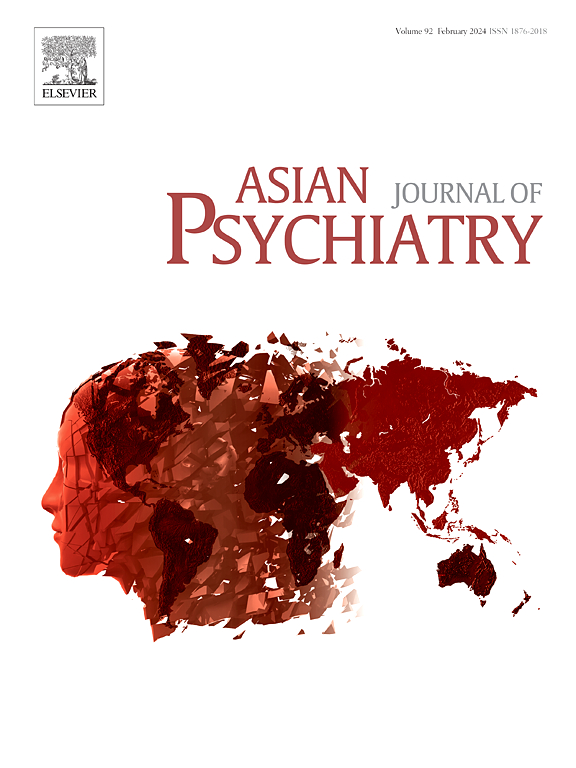A rapid bedside inventory for post-electroconvulsive therapy cognition: Derivation and validation of the electroconvulsive therapy–cognition inventory (ECT-CI)
IF 4.5
4区 医学
Q1 PSYCHIATRY
引用次数: 0
Abstract
Background
Electroconvulsive therapy (ECT) is effective for treatment-resistant major depressive disorder (MDD), but peri-treatment cognitive effects require rapid, accurate bedside assessment. We developed and prospectively validated the Electroconvulsive Therapy–Cognition Inventory (ECT-CI).
Methods
Single-centre, prospective, assessor-masked diagnostic-accuracy/psychometric study including adults with MDD initiating first-course ECT (n = 54; assessed ≤48 h pre-ECT and 7–10 days post-ECT) and age-matched healthy controls (n = 54, single assessment). The reference standard was a DSM-5-TR–anchored, blinded clinical determination of clinically significant cognitive impairment (yes/no) rendered independently by two psychiatrists, who were masked to index-test results.Index tests were ECT-CI (primary) and MoCA (comparator). The primary endpoint was post-ECT ROC AUC; secondary endpoints included pre–post responsiveness, administration time, and inter-rater agreement (Lin’s CCC). Prospectively registered (ChiCTR2400094414).
Findings
Among 108 participants, ECT-CI declined from 24.99 to 20.07 after ECT (mean change 4.92; 95 % CI 4.17–5.67), whereas MoCA showed no change. Post-ECT discrimination favoured ECT-CI over MoCA (AUC 0.972 [95 % CI 0.928–1.000] vs 0.852 [0.751–0.953]). The operational ECT-CI cut-off (≤21) yielded sensitivity 0.970 and specificity 0.905; MoCA’s optimal cut-off (25.5) yielded sensitivity 0.909 and specificity 0.667. ECT-CI required 5.9 ± 2.1 min versus 10.7 ± 3.9 min for MoCA. Inter-rater reliability for ECT-CI was high (Lin’s CCC 0.922; 95 % CI 0.810–0.969).
Interpretation
ECT-CI outperformed MoCA for detecting clinically defined post-ECT cognitive impairment, was more responsive to short-term change, and was briefer to administer. An operational threshold of ≤ 21 supports pragmatic bedside use; external multicentre validation is warranted.
电惊厥治疗后认知的快速床边清单:电惊厥治疗认知清单(ECT-CI)的推导和验证。
背景:电惊厥疗法(ECT)对治疗难治性重度抑郁症(MDD)有效,但治疗前后的认知效果需要快速、准确的床边评估。我们开发并前瞻性地验证了电惊厥治疗-认知量表(ECT-CI)。方法:单中心、前瞻性、评估者屏蔽的诊断准确性/心理测量学研究,包括开始第一疗程ECT的成年重度抑郁症患者(n = 54;ECT前≤48 小时和ECT后7-10天评估)和年龄匹配的健康对照(n = 54,单评估)。参考标准是以dsm -5- tr为基础,由两名精神科医生独立进行的临床显著认知障碍(是/否)的盲法临床测定,他们对指标测试结果不知情。指标测试为ECT-CI(主要)和MoCA(比较)。主要终点为ect后ROC AUC;次要终点包括前后反应性、给药时间和患者间协议(Lin’s CCC)。前瞻性注册(ChiCTR2400094414)。结果:在108名参与者中,ECT-CI从24.99下降到20.07(平均变化4.92;95 % CI 4.17-5.67),而MoCA没有变化。ect后歧视优于MoCA (AUC 0.972[95 % CI 0.928-1.000] vs 0.852[0.751-0.953])。操作性ECT-CI截止值(≤21)敏感性0.970,特异性0.905;MoCA的最佳临界值为25.5,灵敏度为0.909,特异性为0.667。对于MoCA, ECT-CI需要5.9 ± 2.1 min,而10.7 ± 3.9 min。ECT-CI的评估间信度较高(Lin’s CCC 0.922; 95 % CI 0.810-0.969)。解释:ECT-CI在检测临床定义的ect后认知障碍方面优于MoCA,对短期变化反应更灵敏,而且给药时间更短。≤ 21的操作阈值支持实用的床边使用;外部多中心验证是必要的。
本文章由计算机程序翻译,如有差异,请以英文原文为准。
求助全文
约1分钟内获得全文
求助全文
来源期刊

Asian journal of psychiatry
Medicine-Psychiatry and Mental Health
CiteScore
12.70
自引率
5.30%
发文量
297
审稿时长
35 days
期刊介绍:
The Asian Journal of Psychiatry serves as a comprehensive resource for psychiatrists, mental health clinicians, neurologists, physicians, mental health students, and policymakers. Its goal is to facilitate the exchange of research findings and clinical practices between Asia and the global community. The journal focuses on psychiatric research relevant to Asia, covering preclinical, clinical, service system, and policy development topics. It also highlights the socio-cultural diversity of the region in relation to mental health.
 求助内容:
求助内容: 应助结果提醒方式:
应助结果提醒方式:


